Bradley’s work is certainly social commentary on this part of the world. Santa Fe has become very “Anglofied” by all the tourists and summer residents changing the Spanish town in Indian country. These constituencies feel that in many ways it was better before we came. Yet, assimilation is inevitable and the Anglos have brought some things that everyone can appreciate. Bradley’s work is researched and he records in his inimitable style Society, Social Movements and Culture. His work shows his sense of humor in the incongruous groups he forms including locals, celebrities, many of whom visit or live here, as well as those deceased and fictional characters.
I have many favorite pictures in this exhibition and many others that are included in the catalog by Valerie K. Verzuh, curator at the museum and friend of the artist. Unfortunately, there has been a clearly conscious decision in most cases not to identify characters in the paintings which I am sure is often because there are too many figures to identify and also to protect the guilty!
Let us start, however, with the Mona Lisa or rather “Pow Wow Princess, Southwest”, 2009. It was purchased by the Museun of Indian Arts & Culture. Bradley has done a series of these including one of the artist Georgia O’Keeffe as the Mona Lisa. In this case, the sitter is also identified by her Miss Indian Universe sash which is, of course, not only a commentary on the enigmatic Mona Lisa but also on the Miss Universe Contest. I am sure someone in the area will know who this young lady is. One can see on the rampart a dollar bill which might well refer to how much money is spent on art these days especially in a town that bills itself as the 3rd largest art market in the U.S. Then another interpretation might be that Miss Universe usually ends up promoting products once she has the title. Note the sitter’s watch which has the figure of a dying Indian on horseback slouched over as in James Earle Fraser’s sculpture called, End of the Trail. Santa Fe is the end of the Old Santa Fe Trail and the city’s name is displayed on a hilltop in the background. Her smart phone says “Hollywood Agent” with a phone number, a commentary on many aspects of Santa Fe not only do actors live here also many movies have been made in this town. As you read this Tina Fey is filming “Taliban Shuffle” here, characterized as “Drama, Comedy, Biography” it is based on the memoirs of an American journalist in Afghanistan which apparently has a similar landscape to New Mexico.
Bradley has done a series of dollar bills a hand colored lithograph that we own is called, “Santa Fe Indian Market Dollar”. It is about the money spent at Indian Market in Santa Fe over a single weekend.
The painting “El Farol, Canyon Road Cantina”, 2000, is a gift from James and Margie Krebs to the New Mexico Museum of Art, 2004.2.7 It shows a restaurant a short distance from our home where we go every once in a while to have tapas and sangria. There are many art galleries on the street so El Farol is a famous watering hole for the community with music in the bar area. Here you see Bradley playing sax on stage with some of his friends. Bill and Hillary Clinton have stopped by and are sitting at the “Reserved” table. Georgia O’Keeffe is at the far left and Van Gogh is passed out at the bar! Something for everyone!
.jpg) |
| Photo credit: Blair Clark |
The largest picture in the show is called, “Santa Fe Indian Market” 2002 lent by the University of Wyoming Art Museum, Laramie. There is so much in this panorama I wish I could identify more. On the right a woman potter poses for a TV cameraman while her Anglo husband sells to a line of clients each, holding cash at the ready to buy something that might remain from what the prize-winning celebrity brought to the market. While couples fight over their acquisitions another potter, who unlike her neighbor has no prize ribbons, sits alone and dejected. In the window at the center we see a Mona Lisa type and to her right is Georgia O’Keefe staring or glaring at her. All the way on the left are the Lone Ranger and Tonto and to their right is a Koshare, an Indian clown who lends comic relief to the dances , on his a skate board carrying a stereotypical watermelon. Behind them are the Natives’ booths erected in front of the shops around the Plaza and, of course in the foreground you see the ubiquitous tourist photographer.
The one sad note about this show is that, as acknowledged in the catalog, David Bradley has been diagnosed with ALS, Amyotrophic Lateral Sclerosis, better known as Lou Gehrig’s Disease, which is considered terminal. His expressed concern is, however, the work that he still wishes to complete in this life time.





No comments:
Post a Comment